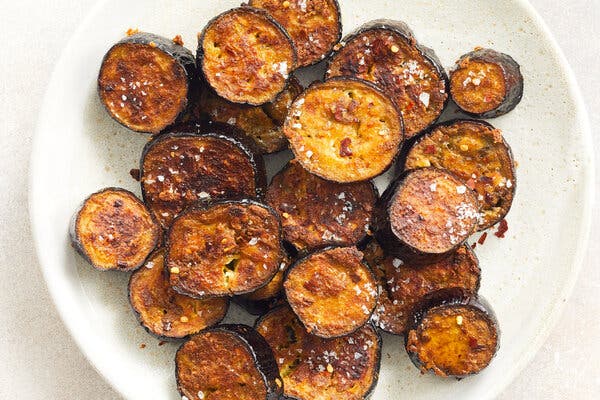This summer staple has a reputation of being bitter, seedy, even greasy at times, but a few small considerations can make it excellent.
Eggplant is much maligned. It’s known for being bitter and seedy, woolly and dry, even greasy at times. And, of course, it can be all of these things when it isn’t treated right. Eggplant is a diva, and with some attentiveness to its needs, it can become a crisp, creamy delight.
To get your head around cooking eggplant well, handle it more like a winter squash: Add plenty of seasoning and time in the oven to reveal its sweet, tender side.
Recipe: Spiced Roasted Eggplant
Choose a good eggplant. Eggplant’s purple skin camouflages signs of decay. Buy eggplants that feel dense, not hollow, and don’t have any sunken spots — they’ll have fewer bitter seeds. And don’t let them hang around in your fridge; they turn bad quicker than they let on.
Consider the end goal when you cut your eggplant. Maximizing the amount of exposed flesh means more caramelization, but slicing or dicing too small will make any creamy middles disappear and leave you with crinkly skins. Slice rounds a good inch thick, and dice a similar size.
Use eggplant’s spongy quality to your advantage. Any generous seasoning will be absorbed. What might seem like too much olive oil or salt will dial up eggplant’s delicate flavor, not cover it up. Unlike frying, which can saturate the eggplant with too much oil, an oil-glossed roasting at high heat leaves the surface of the slices golden and tambourine taut. Lay the eggplant on a parchment-lined baking sheet to roast so tender pieces don’t stick and tear when you flip or stir.
Roast the eggplant for longer than you think. With its high water content, eggplant caramelizes deeply only after heat drives off its wetness. High heat evaporates the water in the eggplant quickly, breaking down interior cell walls and collapsing the flesh to the consistency of baba ghanouj. Both sides of the slices, or all sides of your dice, need heat to caramelize, so flip or stir halfway through cooking to give all sides a chestnut-colored finish.
There are many places to go with roasted eggplant. You could eat it as a side, or serve it as a main with lentils and yogurt, and lots of herbs. But you could also use it to begin ratatouille, pasta alla Norma or İmam bayıldı. Its caramelized exterior and soft inside add richness to dishes and can take on any flavors you want your summer vegetables to carry.
+
